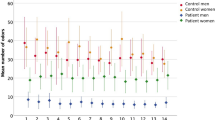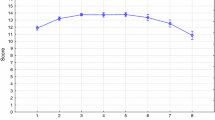Abstract
Olfactory training (OT), smelling odours, twice per day for an extended period, can improve the olfactory function in adults. The aim of the current study was to investigate whether OT can improve the olfactory function of children aged 8 years old. Odour thresholds and odour identification ability were compared between two groups across three separate testing sessions (baseline, 6-week post-baseline, 12-week post-baseline). After the baseline test, the control group (n = 21) completed 6 weeks of bi-daily OT with odourless stimuli, whereas the experiment group (n = 20) completed 6 weeks of bi-daily OT, smelling four different odours (eucalyptus, lemon, clove, rose). A repeated measure analysis of variance was used to test for group differences across the three testing sessions. Six weeks after OT had been completed, participants in the experiment group demonstrated a significant increase in odour identification scores (9.95 to 11.20), compared to the control group who demonstrated no increase (10.48 to 10.48). No group differences in odour threshold ability were found.
Conclusion: Six weeks of OT enhances odour identification ability, but not odour thresholds, in 8-year-old children.
What is Known: • Smell loss and dysfunction are associated with negative health outcomes such as depression and increased risk of consuming contaminated food. • Olfactory training can improve sense of smell in adults. | |
What is New: • Olfactory training improves odour identification ability in 8-year-olds. • Olfactory training does not appear to enhance odour acuity in 8-year-olds. |

Similar content being viewed by others

Data availability
The data is not available due to confidentiality reasons.
Change history
23 February 2021
Anna Oleszkiewicz's orcid has been updated.
Abbreviations
- OT:
-
Olfactory training
References
Sorokowska A, Schriever VA, Gudziol V, Hummel C, Hähner A, Iannilli E, Sinding C, Aziz M, Seo HS, Negoias S, Hummel T (2015) Changes of olfactory abilities in relation to age: odor identification in more than 1400 people aged 4 to 80 years. Eur Arch Otorhinolaryngol 272:1937–1944
Oleszkiewicz A, Schriever VA, Croy I, Hähner A, Hummel (2019) Updated Sniffin’ Sticks normative data based on an extended sample of 9139 subjects. Eur Arch Otorhinolaryngol 276(3):719–728
Al Aïn S, Poupon D, Hétu S, Mercier N, Steffener J, Frasnelli J (2019) Smell training improves olfactory function and alters brain structure. Neuroimage 189:45–54
Mahmut MK, Uecker FC, Göktas Ö, Georgsdorf W, Oleszkiewicz A, Hummel T (2020) Changes in olfactory function after immersive exposure to odorants. J Sens Stud 35:e12559
Sorokowska A, Drechsler E, Karwowski M, Hummel T (2017) Effects of olfactory training: a meta-analysis. Rhinology. 55:17–26
Oleszkiewicz A, Hanf S, Whitcroft KL, Haehner A, Hummel T (2018) Examination of olfactory training effectiveness in relation to its complexity and the cause of olfactory loss. Laryngoscope. 128(7):1518–1522
Haehner A, Tosch C, Wolz M, Klingelhoefer L, Fauser M, Storch A, Reichmann H, Hummel T (2013) Olfactory training in patients with Parkinson’s disease. PLoS One 8(4):e61680
Langdon C, Lehre E, Laxe S, Alobid I, Quinto L, Berenguer J et al (2018) Olfactory training in posttraumatic smell impairment: mild improvement in threshold performances—results from a randomized controlled trial. J Neurotrauma 35(22):2641–2652
Mori E, Petters W, Schriever VA, Valder C, Hummel T (2015) Exposure to odours improves olfactory function in healthy children. Rhinology. 53(3):221–226
Wechsler D (2014) WISC-V Technical and interpretive manual. Pearson, Bloomington
Oleszkiewicz A, Walliczek-Dworschak U, Klötze P, Gerber F, Croy I, Hummel T (2016) Developmental changes in adolescents’ olfactory performance and significance of olfaction. PLoS One 11(6):e0157560
Stevenson RJ, Mahmut M, Sundqvist N (2007) Age-related changes in odor discrimination. Dev Psychol 43(1):253–260
Welge-Luessen A, Leopold D, Miwa T (2013) Smell and taste disorders diagnostic and clinical work-up. In: Welge-Luessen A, Hummel T (eds) Management of smell and taste disorders-a practical guide for clinicians. Thieme Publishing Group, Stuttgart, pp 49–57
Hummel T, Sekinger B, Wolf SR, Pauli E, Kobal G (1997) ‘Sniffin’ Sticks’: olfactory performance assessed by the combined testing of odor identification, odor discrimination and olfactory threshold. Chem Senses 22(1):39–52
Schriever VA, Agosin E, Altundag A, Avni H, Cao Van H, Cornejo C et al (2018) Development of an international odor identification test for children: the universal sniff test. J Pediatr 198:265–272.e3
Hummel T, Smitka M, Puschmann S, Gerber JC, Schaal B, Buschhüter D (2011) Correlation between olfactory bulb volume and olfactory function in children and adolescents. Exp Brain Res 214(2):v285–v291
Chen B, Haehner A, Mahmut MK, Hummel T (2020) Faster olfactory adaptation in patients with olfactory deficits: an analysis of results from odor threshold testing. Rhinology 0:0. https://doi.org/10.4193/Rhin19.465
Monnery-Patris S, Rouby C, Nicklaus S, Issanchou S (2009) Development of olfactory ability in children: Sensitivity and identification. Dev Psychobiol 51:268–276. https://doi.org/10.1002/dev.20363
Acknowledgements
We would like to thank Professor Thomas Hummel for their guidance on this study and feedback on this manuscript.
Funding
This work was supported by the Polish Ministry of Science and Higher Education scholarship for years 2018–2020 (#626/STYP/12/2017) and the National Science Center Poland OPUS grant (2020/37/B/HS6/00288) to AO.
Author information
Authors and Affiliations
Contributions
Mehmet K. Mahmut was responsible for the data analyses, drafting of the initial manuscript and revision of the manuscript. Michał Pieniak, Katarzyna Resler, Valentin A. Schriever and Antje Haehner were responsible for the conceptualization, design and investigation of the study, and reviewing the manuscript. Anna Oleszkiewicz was responsible for the conceptualization, design and investigation of the study, securing research funding, reviewing the manuscript and supervision of the project.
Corresponding author
Ethics declarations
Ethics approval and consent to participate
This study was performed in line with the principles of the Declaration of Helsinki. Ethics approval was received from Wroclaw University’s ethics committee. All participants gave consent prior to beginning the study.
Consent for publication
All authors named consent to the publication of this manuscript.
Competing interests
The authors declare no competing interests.
Additional information
Communicated by Peter de Winter
Publisher’s note
Springer Nature remains neutral with regard to jurisdictional claims in published maps and institutional affiliations.
Rights and permissions
About this article
Cite this article
Mahmut, M.K., Pieniak, M., Resler, K. et al. Olfactory training in 8-year-olds increases odour identification ability: a preliminary study. Eur J Pediatr 180, 2049–2053 (2021). https://doi.org/10.1007/s00431-021-03970-y
Received:
Revised:
Accepted:
Published:
Issue Date:
DOI: https://doi.org/10.1007/s00431-021-03970-y



